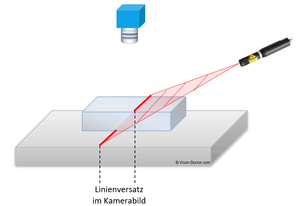Laser triangulation
Triangulation is the determination of distances by measuring angles within triangles using trigonometric functions.
If a laser point(one-dimensional measurement) or a laser line (two-dimensional measurement; light section method) is projected at an angle onto an object, the line or point is offset depending on the height of the object. The offset is a measure of the height and can be recorded by a camera. Calibration can be used to convert the offset (in pixel coordinates) into world coordinates (e.g. in mm).
 Principle of laser triangulation (source: Vision Doctor).
Principle of laser triangulation (source: Vision Doctor).
The more oblique (flatter) the laser is projected onto the object, the greater the offset and the more accurately small differences in height can be measured. However, this is only possible in a small measuring or working range. The measurement accuracy can then be up to a few micrometers.
If the angle of the laser beam falls very steeply onto the object, large height differences can be measured, but at the expense of lower measuring accuracy.
If objects are moved perpendicular to a laser line, they can be measured three-dimensionally (point cloud).
The oblique incidence of the laser light on the object can lead to shadowing. It is then not possible to measure in the shadowed areas.
The laser and camera are often permanently installed in a housing and are then called laser triangulation sensors or 3D scanners.
Comparable measurement methods are the fringe light projection method(Gray code) or the phase shift method (λ/4-shifted sequence of sinusoidal phase grating patterns).
Other optical distance measurement methods are usually the time-of-flight method for long distances (> 1m) and laser interferometry or confocal chromatic distance measurement for short distances.
